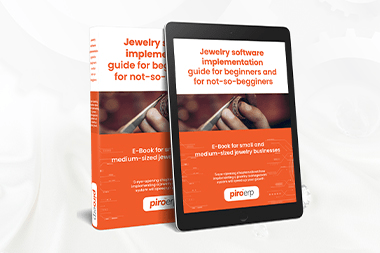
Gold price volatility has become a pressing concern for jewelers in 2025. With prices reaching record highs, jewelry businesses are under increasing pressure to maintain profitability while managing inventory effectively. This article explains how jewelry software can help businesses handle these challenges through automated pricing, real-time jewelry inventory management, and data-driven decision-making.
What does this gold price volatility mean for jewelry businesses?
The gold price volatility is often an indicator of complex economic and political events. In short, when market uncertainty rises and trust in fiat currencies fades, gold rallies.
The price increase we have seen in the last three months - from August 2025 to November 2025 - is unprecedented. In 2024–2025, the price of gold surged by more than 50%.
Such wild fluctuations have thrown the jewelry industry into turmoil. Jewelers of all kinds - from small local shops to online retailers and manufacturers - are grappling with rising material costs and uncertainty.
How can you stay profitable if you created a price quote for a custom piece, fixed the price with the customer, and then the gold price volatility kept rallying in the following weeks?
What is the actual value of your jewelry inventory management? Jewelry inventory management is disrupted.
When is the best time to buy gold? Jewelry companies can lose a lot of money in a short period if they are forced to buy gold near a new all‑time high.
Those using jewelry software can stay calm.
How different jewelry companies are coping
From a jewelry inventory management point of view, jewelry companies fall into three groups:
- Companies using spreadsheets for cost calculation and jewelry inventory management tracking
- Companies using a generic ERP, POS, or jewelry inventory management system with no live market price feed
- Companies using jewelry software with automated cost/price calculations based on daily gold and other metal prices
Needless to say, those in the last category are better protected. Software like PIRO can automatically update gold price volatilities in the system at any frequency. This affects your jewelry inventory management valuation and sales price calculation for made-to-order items, and increases the accuracy of price quotes for custom jewelry orders.
Seeing their gold reserves relative to the volume of orders in the queue helps jewelry companies plan gold purchases strategically.
Impact of a Gold Price Increase on Small Local Jewelry Retailers
Small independent jewelers are feeling immediate pressure to adjust their prices as gold costs climb. Many have had no choice but to raise price tags on gold jewelry - sometimes by 10–30% - to avoid selling at a loss. Frequent price changes, however, risk alienating customers, so some local retailers try to limit how often they adjust prices.
Profit margins are getting squeezed.
Volatility is forcing local jewelers to rethink jewelry inventory management. The old strategy of stocking up on gold items in advance is now risky - nobody wants to be stuck holding high‑cost inventory that might lose value if gold plunges.
Small retailers are heeding this advice: they order in smaller batches more frequently and favor fast‑moving, classic pieces over speculative styles.
Impact of a Gold Price Increase on Online Jewelry Stores
Online jewelry retailers, including direct-to‑consumer (D2C) brands and e‑commerce marketplaces, face many of the same cost pressures but have some unique challenges and tools.
Pricing is extremely transparent online - customers can compare prices with a few clicks - which means online stores must be very strategic in pricing adjustments. Many online jewelers have indeed raised prices to keep up with gold’s climb, but they do so carefully to avoid driving shoppers to competitors or alternative products.
The advantage for online players is the ability to implement dynamic pricing more fluidly. Their websites can be updated instantly, and some have pricing algorithms tied to metal markets.
Industry jewelry software providers note that jewelers can connect jewelry inventory management systems to live metal‑price feeds so that, if the gold spot price goes up, the system reflects that in the material cost basis, even suggesting updated retail prices in real time.
Impact on Jewelry Manufacturers (and Wholesalers)
Jewelry manufacturers and wholesalers - the companies that produce gold rings, chains, and components to supply retailers - are on the front lines of gold‑price increases. For them, gold is a raw material input, often accounting for a large share of the cost of goods.
When gold price volatility rises, production costs jump immediately, which can wreak havoc on pricing agreements. Many manufacturers have contracts or at least price lists quoted to their retail clients; with gold’s rapid ascent, these quotes have had to be revised frequently.
In some cases, price hikes of 10–30% were implemented to ensure that, if gold keeps climbing, the manufacturer won’t be selling at a loss (source: National Jeweler). This is a stark change: such large adjustments were once rare in the industry outside multi‑year periods, but now they are happening in a matter of months.
What’s your strategy to protect your jewelry company from price volatility?
Jewelry businesses are deploying a range of strategies to cushion the impact of gold’s volatility. Key approaches include financial hedging, pricing tactics, jewelry inventory management and supply‑chain adjustments, and upgrading their tracking systems.
Why PIRO Helps in Volatile Times
PIRO has been a safe haven for jewelry companies during the past few turbulent years:
- It’s cloud‑based, so users were able to switch quickly to working from home during COVID.
- They had zero headaches during the gold‑price rally.
It’s time to put your faith in PIRO. Mitigate your risk - whatever new challenge is around the corner for this industry.
Frequently Asked Questions
- How does gold price volatility affect jewelry businesses?
Gold price volatility impacts jewelry manufacturers and retailers by changing production costs, pricing, and inventory valuation. Jewelry software helps mitigate these effects by automating real-time pricing and tracking. - How does jewelry software support jewelry inventory management?
Jewelry software automates jewelry inventory management by updating product costs when gold prices fluctuate, keeping pricing and profit margins accurate. - Why is jewelry software essential during gold price volatility?
It provides real-time metal pricing integration, improves inventory control, and enables jewelers to make data-driven purchasing decisions. - What are the best practices for managing jewelry inventory during volatile markets?
Use live metal feeds in your jewelry software, track inventory turnover closely, and plan purchases strategically to avoid overpaying for gold.






